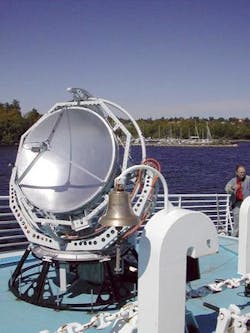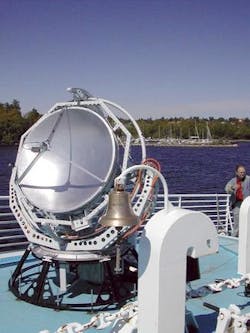Developments in maritime satellite communications should bring users, including operators of drilling fleets and floating production systems, more efficient services at lower cost.
VSAT - very small aperture - services are challenging the dominant position traditionally held by Inmarsat. A key advance of VSAT is the development of stabilized antenna systems. VSAT communications often operate on the high-frequency C and Ku bands, in contrast to the low-frequency L band used by Inmarsat. Because the beam is narrower in high-frequency communications, it is important to keep the antenna locked closely onto the satellite signal.
C2SAT Communications will launch a stabilized antenna system this year. Unlike conventional systems in which the antenna reflector is mounted on a central pole and can only move on a narrow axis, the C2SAT antenna is based on a patented gimbals system with up to four stabilized axes.
Fiber-optic laser gyros work in conjunction with a tracking device to keep the antenna locked onto the satellite. The gyros are connected to servomotors located at the circumference of the antenna on each axis, which constantly adjust the direction of the antenna. In this way, improved pointing accuracy is achieved without the need to balance each axis. This saves time during installation and helps reduce maintenance needs, according to corporate communications manager Mats Back. Adjustment of alignment takes just 50 milliseconds.
The satellite location is logged every 10 ms. If contact with the satellite is lost through the intervention of an island or another large object, or should the signal’s power deteriorate significantly, the system can predict the position of the satellite and re-establish contact as soon as the object moves out of the way, without having to re-start. This tracking ability can be retained for 15-30 minutes after contact is lost, Back says.
Better link budget
At the same time, the system keeps monitoring for the strongest signal. If it finds a stronger signal than the one predicted by the gyro, it logs onto the new signal. The system’s accuracy makes it possible to maintain direction within a 0.1 dB range of the optimal signal peak from the satellite. Other systems commonly suffer a loss of 3 dB due to misalignment - equivalent to the loss of half the power or half the transmission speed. In other words, they deliver a lot less in practice than they promise on paper, while the C2SAT system supplies the bandwidth that the user has paid for, Back claims.
The improved pointing accuracy of the C2SAT system gives the user a better link budget, allowing the power requirement and size of reflector to be closely dimensioned to the level of performance required. The user can do this through higher-speed downloading or uploading of data, or an increased number of telephone channels, or through reduced transmission power.
The C2SAT system is also advantageous to operators of fleets such as drilling rigs using the open standard digital video broadcasting return channel via satellite (DVB-RCS) technology. It allows a larger number of end-users to share the same satellite link and similarly enables the customer to make use of the capacity he has paid for.
As the satellite finding system is part of the software delivered with the C2SAT stabilized antenna, it is not necessary for the vessel or rig to have its own gyro or compass, as is usually the case with permanently moored production floaters.
C2SAT plans to start production of its stabilized antenna later this year. The first model to be produced will have a 1.2-m reflector and will weigh less than 200 kg. This compares favorably with the weight of rival antennas.
An important milestone in maritime satcoms is approaching with the shutdown of the Inmarsat A analogue service at the end of 2007. Users must therefore reconsider which service best meets their needs, Back says. At present, only Inmarsat offers global coverage, while VSAT users need to have contracts with various satellite operators in different spot-beam areas to achieve worldwide coverage. However, this situation will change when Boeing completes implementation of its Connexion service. Connexion will provide global coverage through a network of three satellites, one of which is already in space. The other two will be launched this year and in 2006.
As satcoms technology becomes more sophisticated, costs keep falling, and providers are offering a greater choice of service. Inmarsat offers relatively inexpensive terminals, but its traffic fees are very high, with charges of $10/minute not unusual. VSAT terminals cost more, but the traffic fees are lower. The present breakeven point is somewhere between five and nine minutes of daily use, but this is set to come down as VSAT fees are lowered. Some VSAT service providers are also introducing flat fees, giving users much closer control over satcom costs.
A further advantage of VSAT is that a higher volume of data can be sent over high-frequency bandwidths. The rule of thumb calculation is that you can transmit 10 times the information content with VSAT as with Inmarsat for the same cost, Back says.
For more information, contact Mats Back, C2SAT Communications. Tel +46 8748 0144, fax +46 8748 0143, [email protected], www.c2sat.com.




